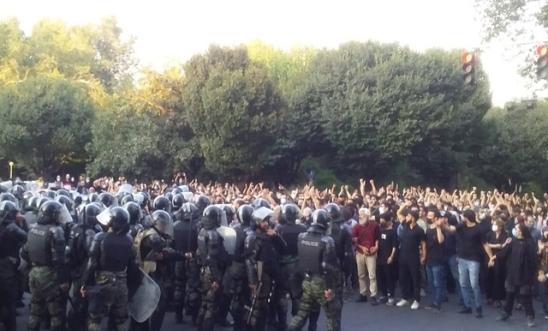
Press releases
Iran: Authorities continue to try to ‘crush the spirit of resistance’ killing at least 23 children

Children represent 16% of the deaths recorded by Amnesty
Families of dead coerced into making video statements to deflect blame from the government
‘The Iranian authorities are systematically harassing and intimidating victims’ families to hide the truth that they have the blood of children on their hands.’ - Heba Morayef
Iranian security forces have killed at least 23 children, demonstrating the authorities’ determination to crush the protests sparked by the death in custody of 22-year-old Mahsa Amini, Amnesty International said today.
Children represent 16% of overall deaths of protesters and bystanders recorded by Amnesty.
The victims include 20 boys aged between 11 and 17; and three girls, two of whom were 16 years old and one 17 years old. Most of the boys were killed by security forces unlawfully firing live ammunition at them. Two boys died after being shot with metal pellets at close range, while three girls and a boy died after fatal beatings by security forces.
So far, Amnesty has recorded the names and details of 144 men, women and children killed by Iran’s security forces during the protests between 19 September and 3 October, but believes the death toll to be higher. The victims recorded are limited to those whose names Amnesty has been able to identify and will continue investigations into reported killings.
Heba Morayef, Amnesty International’s Regional Director for the Middle East and North Africa, said:
“Iran’s security forces have killed nearly two dozen children in an attempt to crush the spirit of resistance among the country’s courageous youth.
“These despicable methods further underline the scale and depravity of the Iranian authorities’ crackdown and provide further proof that all avenues for truth and justice are closed at the domestic level.
“The Iranian authorities have repeatedly ignored all calls to cease the unlawful use of force and to prosecute those responsible for unlawful killings, enforced disappearances, torture and other ill-treatment of protesters, bystanders and of people deprived of their liberty. The price of this systematic impunity is being paid with human lives, including children’s.
“Member states engaging at the UN Human Rights Council should urgently hold a special session and adopt a resolution to establish an international independent investigative and accountability mechanism on Iran.”
Brutal killing of children
Ten of the children were from Iran’s oppressed Baluchi minority and were killed by security forces on the deadliest day of the crackdown(30 September) in Zahedan, Sistan and Baluchistan provinces. Evidence gathered by Amnesty shows at least seven of the children killed in Zahedan were shot in the heart, head or other vital organs.
According to informed sources and audio-visual evidence examined by Amnesty, one of them, Javad Pousheh, aged 11, was shot in the back of his head with live ammunition fired by security forces during a violent crackdown on a protest taking place after Friday prayers outside a police station and near a large prayer site. The bullet exited through his right cheek leaving a large gaping hole.
The remaining 13 children were killed in the provinces of Tehran (5), West Azerbaijan (4), Alborz (1), Kermanshah (1), Kohgilouyeh and Bouyer Ahmad (1), and Zanjan (1). Two of the children killed were Afghans – a 14-year-old boy, Mohammad Reza Sarvari, and a 17-year-old girl, Setareh Tajik.
Exposing government propaganda
On 7 October, the lawyer of Mohammad Reza Sarvari - who was shot dead by security forces during protests in Shahr-e Rey, Tehran province on 21 September - published a copy of the child’s burial certificate online. It listed the cause of death as “bleeding and shattered brain tissue” caused by “being hit with a fast-moving projectile”. The lawyer wrote that he felt he had to share the official document because authorities are spreading false narratives in state media and through statements increasingly stating “suicide” as the children’s cause of death.
Security forces fired metal pellets and live ammunition at Amir Mehdi Farrokhipour, aged 17, during protests in Tehran on 28 September. According to informed sources, he died from gunshot wounds in his chest, while intelligence officials forced his father to record a video statement stating that his son died during a car accident, threatening to kill or harm his daughters if he refused.
Other examples of the state’s cover up include the cases of two 16-year-old girls, Nika Shakarami and Sarina Esmailzadeh, who were killed after security forces beat them on their heads. Intelligence and security forces subjected their families to intense harassment and intimidation in order to coerce them into recording video statements repeating the official line that their children committed “suicide” by jumping off a roof.
The latest wave of protest killings is rooted in a deep crisis of systemic impunity for the most serious crimes under international law that has long prevailed in Iran and which, given the scale and severity of past and ongoing human rights violations, has not been sufficiently addressed by the UN Human Rights Council. An international investigative and accountability mechanism is urgently needed to collect, consolidate, preserve, and analyse evidence of the most serious crimes and other serious human rights violations committed in Iran.
A history of brutality
In September, Amnesty revealed that Iran’s highest military body instructed commanders of the armed forces in all provinces to “severely confront” protesters who took to the streets following Mahsa Amini death in custody at the hands of Iran’s morality police.
Amnesty has documented widespread, unwarranted use of lethal force including with firearms by Iranian security forces who either intended to kill protesters or should have known with a reasonable degree of certainty that their use of firearms would result in deaths.
Iranian authorities have previously responded to protests with similar patterns of unlawful use of force, including lethal force, which resulted in the death of hundreds of protesters and bystanders, including at least 21 children, during the protests of November 2019.